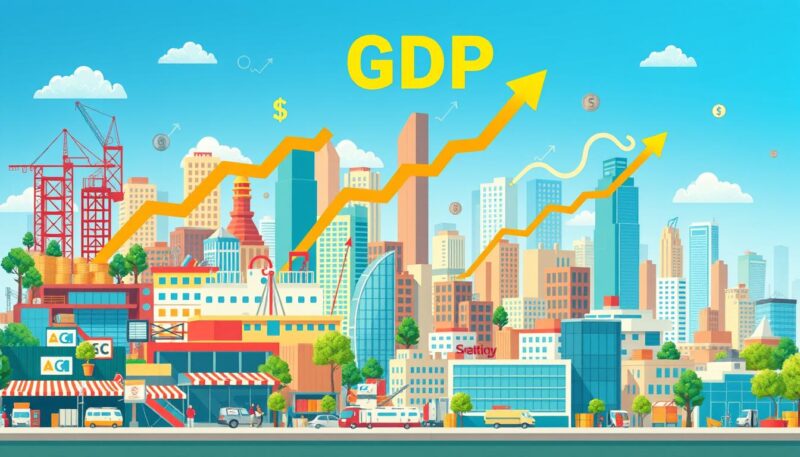Understanding the distinction between GDP and GNP is essential for anyone interested in macroeconomics, as these economic indicators help gauge the health of a nation’s economy. Both Gross Domestic Product (GDP) and Gross National Product (GNP) serve pivotal roles in evaluating national income and economic activity, yet they measure different aspects of a country’s economic output. While GDP assesses the total market value of all goods and services produced within a nation’s borders, GNP accounts for the value created by a nation’s citizens, including production occurring abroad. Given that the United States transitioned from utilizing GNP to GDP as its primary economic measurement in 1991, you might wonder about the implications of these two metrics on your understanding of economic health. In this article, you will explore the core differences between GDP and GNP, their measurement focuses, calculation components, and various scenarios when GDP may demonstrate greater utility than GNP.
Understanding GDP and GNP
To grasp the distinctions between GDP and GNP, it is crucial to first understand their definitions and significance. Both measures offer insights into a country’s economic performance but from different perspectives. GDP focuses on production output within a nation’s borders, while GNP emphasizes the contributions of its citizens, regardless of where they are located.
Definition and Importance of GDP
The GDP definition refers to the total market value of all finished goods and services produced within a nation’s borders over a specific period, typically a year. This economic measure is essential for assessing economic growth, informing policymakers, and guiding international trade decisions. GDP importance lies in its ability to indicate whether the economy is expanding or contracting, which plays a critical role in economic analysis.
Definition and Importance of GNP
The GNP definition encapsulates the total market value of goods and services produced by a country’s residents, irrespective of their location. This measure highlights the economic contributions of citizens, whether at home or abroad, and thus has significant GNP importance for understanding national income generation. GNP provides insights into the financial resources available to residents, including income from overseas investments. As global engagement increases, this perspective on economic activity becomes increasingly relevant.
The Key Differences Between GDP and GNP
The distinction between GDP and GNP revolves around their respective measurement focuses and components of calculation. Understanding these differences not only enhances your grasp of economic terms but also aids in analyzing economic performance through financial indicators.
Measurement Focus
The measurement focus GDP considers economic activity occurring within a specific country’s geographical boundaries. This metric captures the total value of goods and services produced domestically during a designated timeframe. In contrast, measurement focus GNP emphasizes the nationality of the producers, accounting for the total value created by a nation’s residents, whether they are within the country or operating abroad. Thus, GDP includes outputs from foreign nationals working domestically, while GNP excludes this component, providing a different perspective on economic comparison.
Components of Calculation
In terms of GDP calculation, various elements are involved. The main components of GDP include:
- Private consumption (household spending)
- Government spending
- Business investments
- Net exports (exports minus imports)
On the other hand, GNP calculation modifies GDP by incorporating net income earned by residents from investments or work abroad and subtracting the income generated by non-residents within the country. This adjustment allows GNP to reflect the financial impact of global engagements for the country’s citizens. Consequently, while GDP focuses solely on production within borders, GNP provides a broader view by including income from international endeavors.
When is GDP More Useful Than GNP?
In today’s interconnected economy, GDP offers significant GDP usefulness for policymakers and economic analysts. Its reflection of immediate domestic production provides a clearer picture of a nation’s economic health influenced by local economic policies. This clarity is particularly valuable during times of global trade when firms and governments seek a consistent benchmark for comparing economic performance across countries. As of Q3 2021, the U.S. GDP reached $23.8 trillion, indicating a strong domestic production base.
GNP limitations come into play in assessing domestic conditions. While GNP captures income from overseas investments, it can obscure the true state of local economies. In the same quarter, the U.S. GNP was recorded at $23.9 trillion, showing a slight net inflow due to investment activities by U.S. residents. This slight difference, only $0.1 trillion, highlights that while both measures are important, GDP is better positioned to support current economic policy discussions.
The shift from GNP to GDP as the primary economic measure in the U.S. began in 1991, aligning GDP more closely with critical macroeconomic measures like employment and industrial production. Prior to that, GNP was a staple for economic analysis for several decades. The transition reflects a broader integration into the global economy, reinforcing the notion that GDP provides immediate insights into national economic conditions.
Understanding the dynamic relationship between GDP and GNP aids in formulating effective government policy. With GDP focusing strictly on domestic output, it serves as a reliable metric for driving current fiscal strategies and economic initiatives. In contrast, GNP’s inclusion of foreign income can lead to variability and sometimes less reliable indicators of domestic economic strength.
Conclusion
In summary, understanding the differences between GDP and GNP is crucial for a comprehensive economic understanding. While both metrics measure economic performance, they approach it from distinct perspectives. GDP, which stands for Gross Domestic Product, focuses on the total market value of all goods and services produced within a country’s borders, reflecting domestic production. In contrast, GNP, or Gross National Product, highlights the income generated by a nation’s residents, whether it is earned at home or abroad, offering a broader view of national economic activity.
The subtle nuances illustrated by the difference of less than 0.5% between the U.S. GDP and GNP in 2003 exemplify how these two measures can closely align. However, the implications can vary widely, especially in economies impacted by foreign investments and profit transfers, as seen in countries like Ireland. Such scenarios reinforce the importance of recognizing the summary of GDP and GNP differences when evaluating monetary policy and crafting economic strategies.
Ultimately, as you navigate through the realms of both metrics, the knowledge gained can inform your understanding of economic conditions and guide decisions around investments and policies. Recognizing whether to prioritize GDP or GNP can be pivotal for stakeholders, economists, and policymakers aiming for sustainable economic growth and effective monetary policy.

Hey, I’m Derek Vaughn. I love exploring how tech, business, and productivity come together to shape the way we work. At PulseBlueprint, I write about tools, trends, and strategies that actually make a difference—no fluff, just real-world insights.









